So let me show you how my last game in the New Year Open ended. I was Black against National Master Kenan Zildzic. After White’s move 45. Qc4 we got to the following position. I should mention, because it’s important, that the time situation was significantly in my favor. I had about 18 minutes left for the rest of the game and my opponent had about 11.
FEN: 8/5qk1/1p2r1p1/p7/P1QP4/1P3Pb1/2B3K1/5R2 b – – 0 45
What would you do here? I had a curious hallucination in this position — a hallucination that turned out to win the game! The simplest move for Black here is simply to retreat the bishop with 45. … Bd6. I didn’t like this because of 46. d5 Re5 47. Qd4, when the rook is pinned and Black’s attack is stymied, but I overlooked the fact that White’s d-pawn is hanging! Black can simply play 47. … Qxd5 48. Qxd5 Rxd5 with a totally easy draw.
However, because I overlooked this I played the brilliant/foolish move 45. … Qe7!?, sacrificing my bishop. Actually, the clock situation was another reason I played this. I was almost certain that this move would take Zildzic by surprise, and I would gain some more time on the clock. I was right — by the time he answered, he was down to 8 minutes for the rest of the game.
Here is the position again, and now it’s White who faces a difficult decision. Can he win? Can he draw? It’s incredibly unclear.
FEN: 8/4q1k1/1p2r1p1/p7/P1QP4/1P3Pb1/2B3K1/5R2 w – – 0 46
I think there are four main variations, and I’ll give you what I think is the best one for White first.
Variation 1: 46. Be4! Shut down that e-file! Now Black finally has to decide where to put his bishop (which has been hanging, believe it or not, since move 43). I think that 46. … Bf4 is best, but now White’s king can make a break for freedom with 47. Kf2!
FEN: 8/4q1k1/1p2r1p1/p7/P1QPBb2/1P3P2/5K2/5R2 b – – 0 47
Here Black has to choose between 47. … Qh4+ 48. Ke2 Rd6, creating a fortress that will be very difficult for White to break through, or the wild and woolly exchange sac 47. … Rxe4?! 48. ef Qxe4 49. Qc3. In this line, though I don’t think Black is actually playing to win — it’s just a question of whether he can draw or not.
Variation 2 (go back to Diagram 2): The most obvious try for White is to take the bishop with 46. Kxg3. Now Black can obviously draw with 46. … Qg5+ 47. Kf2 Qe3+, and that’s why Zildzic didn’t play it. (We were both in a situation where we could only win prize money by winning. As I said in my previous post, I didn’t care much about the prize money, but Zildzic said that was the only thing he cared about — he didn’t want a draw under any circumstances.)
However, I think that Black may actually be winning after 46. Kxg3 Re2!!, cutting off the King’s retreat!
FEN: 8/4q1k1/1p4p1/p7/P1QP4/1P3PK1/2B1r3/5R2 w – – 0 47
I did not see this during the game, but perhaps I might have found it. Now 47. f4 Qe3+ would lose as in the game. 47. Qd5 would lose to 47. … Qc7+ 48. f4 Qc3+ 49. Rf3 Qe1+. (Amazing how Black’s queen keeps finding these squares!) The best I can see for White is 47. d5 Qe5+ 48. Qf4, which transposes into our next variation.
Variation 3 (Go back to Diagram 2): 46. d5 Re2+ 47. Kxg3 Qe5+ 48. Qf4 Rg2+! 49. Kxg2 Qxf4.
FEN: 8/6k1/1p4p1/p2P4/P4q2/1P3P2/2B3K1/5R2 w – – 0 50
This position is difficult to assess. Superficially it looks as if White should be able to hold, and that may in fact be correct. But Black’s queen has so many diagonals and files to penetrate on, White will constantly have to be on the lookout for forks. Even if he manages to set up a fortress with his bishop on e4 and rook on d3, there are still going to be possibilities that I will waltz my king and queen in on the dark squares and checkmate him, or undermine the bishop’s outpost with … g5-g4. Finally, let me remind you, there’s the time factor. By now White has 7 minutes left for the game and I have 15 minutes. Given all of these considerations, I would say that from the practical point of view, Black has at least a 50 percent chance of winning and maybe even 75 percent.
Variation 4 (go back to Diagram 2): As it turned out, White played a plausible-looking move that simply loses outright. He played 46. f4? Re2+ 47. Kg3 Qe3+ 48. Rf3 Qg1+ (he probably overlooked this, another sneaky back-rank check) and here he resigned.
FEN: 8/6k1/1p4p1/p7/P1QP1P2/1P3RK1/2B1r3/6q1 w – – 0 49
After 49. Kh4 Qh2+ 50. Rh3 Qxf4 mate would be an elegant finish.
After the game, which was the last one in the tournament to finish, Zildzic seemed to be completely gobsmacked by the final combination. It had never even occurred to him that he could lose this game. He kept playing the last few moves over and over on our board as if to make sure that he wasn’t dreaming. I did point out to him that he could have had an easy draw on move 44 (one move before the first diagram) but that did not seem to be any consolation.
All I can say is, to modify a line from a long-ago pop song, “When chess is good, it’s oh so good.”
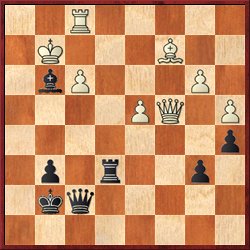
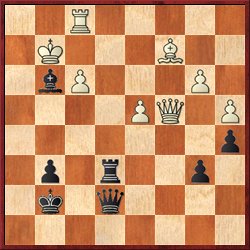
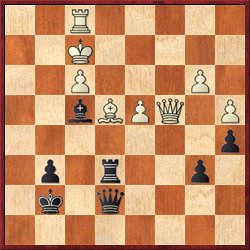
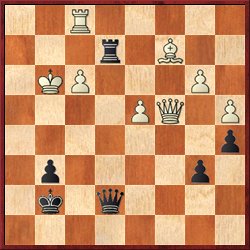
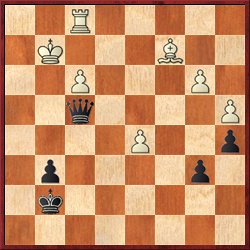
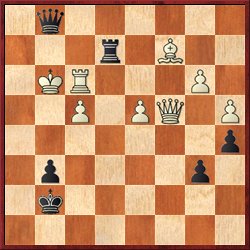



{ 7 comments… read them below or add one }
The line with Re2! is particularly elegant, in the ‘obvious’ looking Kxg3 line. I think though that you might still have had excellent pressure in the Bd6 line, together with Qf4 to follow – probably enough to force a mistake.
Also, in the materially imbalanced variation 3 (Q vs R+minor) white has a passer on the d file which I think could give him good counterchances if he can escape the checks.
Congrats on the brilliant finish, Dana.
There’s a typo in the variation 3 line. It should be Rg2+ 49. Kg2 instead of Rg7+ 49 Kg7.
This was one of those positions where both sides have to use a lot of time to find the best moves. Those three times earlier in the game where you saved time on the clock by using your new “Just Do It” technigue really paid off.
Congratulations!
Mike, thanks for catching the typo. I have made the correction silently. Praveen, you’re right that the passed pawn is important, and it may keep Black from executing some of the more ambitious schemes I was suggesting. (In particular, marching forward with both the king and queen won’t be possible if one of them has to stay on the d-file for blockading duty.) If the pawn weren’t there then I would be confident of a Black victory.
I did some more analysis on the 45. … Bd6 line and I think it looks very dangerous for White. I think that he absolutely must aim for a draw. In the line I wrote about, I think 46. d5? is actually a mistake because of 46. … Re5 47. Qd4 Qf6! breaking the pin and threatening two different rook checks that would win White’s queen. Instead, I think White needs to play 46. Rh1 (something I was also worried about in the game) when Black can sacrifice his rook to force a draw with 46. … Qf4! (a very important square) 47. Qxe6 Qg3+ 48. Kf1 Qxf3+ 49. Kg1, draw. It is totally clear that neither side can afford to play for a win here.
For anyone interested, the results have now been posted at http://bayareachess.com/events/13/106sp.php.
Should be: “After 49. Kh4 Qh2+ 50. Rh3 Qxf4 mate would be an elegant finish.”
Thanks, Ashish. I’ve corrected this typo too. You can tell that writing correct chess notation is not my strong suit, especially when I’m looking at the board from the Black side.
Thanks for setting up your boards from the “reader’s” point of view – makes following along so much more enjoyable. I’ve never understood the point of the White-must-be-below convention that almost all books, even problem collections, seem to use.
This post reminded me of your analysis of certain basketball game ending, with different fascinating variations and possibly surprising outcomes. Well such are the games!
Btw., I think your silent queen move was rather brilliant than foolish all things considered.
{ 1 trackback }